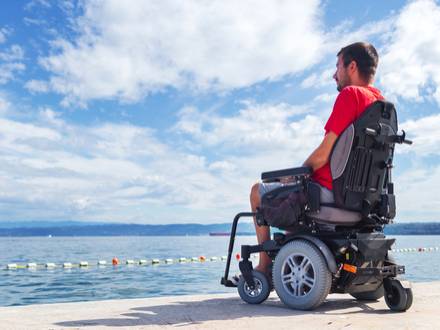121 S. Wilke Road, Suite 301, Arlington Heights, IL 60005
Home and Hospital Visits for Your Convenience
Serving Clients Across 7 Illinois Locations
Recent Blog Posts
Can Mothers Suffer Birth Injuries or Are Only Babies Harmed?
 Bringing a child into the world should be a joyous time. Although some pain is expected, birth injuries can turn a happy event into a painful, life-altering experience. Most people associate birth injuries with various conditions that can affect a baby, but did you know that mothers can be injured also? Some injuries are unavoidable, but others may qualify victims for compensation through a medical malpractice claim.
Bringing a child into the world should be a joyous time. Although some pain is expected, birth injuries can turn a happy event into a painful, life-altering experience. Most people associate birth injuries with various conditions that can affect a baby, but did you know that mothers can be injured also? Some injuries are unavoidable, but others may qualify victims for compensation through a medical malpractice claim.
What kinds of birth injuries can affect mothers, and why do they happen? What compensation can you receive? Your compassionate attorney from Newland & Newland, LLP can support you and help you hold the at-fault parties accountable.
What Kinds of Birth Injuries Can Result from Negligent Medical Care?
Doctors, midwives, nurses, and other medical professionals are expected to uphold high care standards. In these situations, medical negligence is failing to provide the same level of care that another professional with a similar background and training would provide, causing otherwise preventable harm to patients.
Can I Get a Settlement for My Brain Injuries in Illinois?
 Brain injuries are some of the most severe injuries victims can face, often producing life-altering consequences. In fact, traumatic brain injuries contributed to around 190 deaths every day in the U.S. in 2021 and caused many more disabilities. If someone else’s negligence caused your brain injury, you deserve compensation.
Brain injuries are some of the most severe injuries victims can face, often producing life-altering consequences. In fact, traumatic brain injuries contributed to around 190 deaths every day in the U.S. in 2021 and caused many more disabilities. If someone else’s negligence caused your brain injury, you deserve compensation.
What kinds of incidents can lead to brain injuries, and what adverse effects are they likely to produce? How much will your personal injury settlement be? The dedicated attorneys at Newland & Newland, LLP offer free consultations so you can get those vital answers.
How Do Brain Injuries Occur?
A wide variety of situations can lead to brain injuries, such as:
Can I Sue If a Pothole Caused My Motorcycle Crash in IL?
 Drivers often take for granted that the roads they travel are paved smoothly. While potholes and broken pavement can cause problems for passenger vehicles and large trucks, they are especially dangerous for motorcyclists.
Drivers often take for granted that the roads they travel are paved smoothly. While potholes and broken pavement can cause problems for passenger vehicles and large trucks, they are especially dangerous for motorcyclists.
If a poorly maintained interstate, highway, or street causes you to have a motorcycle accident, can you get compensation? Who is liable for paying you? The knowledgeable attorneys at Newland & Newland, LLP can answer those and other questions during your free consultation.
What Causes Potholes?
Potholes, which are holes in a road’s surface, can be different shapes, sizes, and depths. These imperfections can form or worsen due to various factors, including:
-
Surface cracks can gradually expand with normal wear and tear.
How Does Drowsy Driving Cause Dangerous Crashes in IL?
 Most people know that distracted driving, speeding, and driving under the influence of drugs or alcohol are dangerous, often leading to car accidents. Each of those behaviors poses specific risks, and most people try to avoid them. But did you know that drowsiness and fatigue can also cause collisions that produce injuries and fatalities?
Most people know that distracted driving, speeding, and driving under the influence of drugs or alcohol are dangerous, often leading to car accidents. Each of those behaviors poses specific risks, and most people try to avoid them. But did you know that drowsiness and fatigue can also cause collisions that produce injuries and fatalities?
If you were injured in a collision with a drowsy driver, you may be able to get a settlement through a personal injury claim. Working with a local attorney from Newland & Newland, LLP can give you a better chance of reaching a favorable outcome.
Why Is Drowsy Driving Dangerous?
Fatigue can cause impairments that are similar to being intoxicated. According to the Centers for Disease Control and Prevention:
-
The impairments of being awake for 17 hours mimic a 0.05 percent blood alcohol concentration.
Can I Sue If a Car Crash Left Me Paralyzed? | IL
 Car crashes can cause a wide variety of injuries. While some injuries are relatively minor and should improve over time, others leave victims facing life-altering conditions. Catastrophic injuries like spinal cord damage that leads to paralysis may require extensive changes in your daily life. If someone else’s negligence caused your paralysis, you deserve compensation.
Car crashes can cause a wide variety of injuries. While some injuries are relatively minor and should improve over time, others leave victims facing life-altering conditions. Catastrophic injuries like spinal cord damage that leads to paralysis may require extensive changes in your daily life. If someone else’s negligence caused your paralysis, you deserve compensation.
How do you know if you qualify? What kinds of compensation can you receive? The skilled lawyers at Newland & Newland, LLP can discuss these questions and provide answers during your free consultation.
Are There Different Levels of Spinal Cord Injuries?
Vertebrae and cartilage enclose the human spinal cord for protection, but it is still incredibly vulnerable. As the brain’s messenger, the spinal cord controls our sense of touch, ability to move, posture, and support. Blunt impacts, cuts, and punctures can temporarily or permanently damage the spinal cord. The effects are usually focused below the injured location. Paraplegics are paralyzed in their legs and lower bodies, with quadriplegics unable to move any of their limbs.
Do I Have a Valid Medical Malpractice Case?
 Americans go to physicians and healthcare facilities for various reasons, but they all have one thing in common: an expectation of competent care. Unfortunately, medical treatments sometimes lead to injuries, worsen existing conditions, or even cause fatalities, potentially resulting in medical malpractice or wrongful death claims.
Americans go to physicians and healthcare facilities for various reasons, but they all have one thing in common: an expectation of competent care. Unfortunately, medical treatments sometimes lead to injuries, worsen existing conditions, or even cause fatalities, potentially resulting in medical malpractice or wrongful death claims.
How do you know if your situation qualifies? What compensation may be available? The experienced Illinois medical malpractice lawyers at Newland & Newland, LLP will discuss these and other relevant topics during your free consultation.
What Is Medical Malpractice?
When healthcare professionals or facilities accept you as a patient, they obligate themselves to comply with required state and federal care standards, which the Illinois Department of Public Health regulates. When providers do not meet their obligations, you may be eligible to file a compensation claim.
What You Need To Know About Truck Accidents in Illinois
 Americans depend on semi-trucks to transport goods throughout the country. The Chicago area sees a lot of truck traffic due to its status as a major freight hub. The traffic congestion often found in Chicagoland, combined with the large number of trucks in the region daily, makes truck accidents a clear risk.
Americans depend on semi-trucks to transport goods throughout the country. The Chicago area sees a lot of truck traffic due to its status as a major freight hub. The traffic congestion often found in Chicagoland, combined with the large number of trucks in the region daily, makes truck accidents a clear risk.
Car accident claims are often complicated, but truck crash claims have additional layers of complexity. It may be difficult to obtain the compensation you deserve without the assistance of a competent lawyer from Newland & Newland, LLP.
Truck Accident Facts
A fully loaded tractor-trailer weighs up to 80,000 pounds. Especially at higher speeds, the impact force when a truck collides with another vehicle is tremendous. Truck crashes often cause catastrophic injuries, devastating property damage, and fatalities. Some of these truck collision facts may shock you:
What Is Dram Shop Liability in Drunk Driving Crash Claims?
 It is illegal to drive a car when under the influence of alcohol because its effects can cause multiple impairments that make safe driving impossible. When a drunk driver causes a car accident, injured victims may qualify to obtain compensation from the drunk driver. The Illinois Dram Shop Act is a liquor liability law that may allow you to seek compensation from others who may also be responsible.
It is illegal to drive a car when under the influence of alcohol because its effects can cause multiple impairments that make safe driving impossible. When a drunk driver causes a car accident, injured victims may qualify to obtain compensation from the drunk driver. The Illinois Dram Shop Act is a liquor liability law that may allow you to seek compensation from others who may also be responsible.
You must prove liability to receive payment from the driver or other responsible parties. When you work with a personal injury lawyer from Newland & Newland, LLP, we will investigate your accident to determine all guilty parties and help you fight for maximum compensation.
What Are Liquor Liability Laws?
Before states enacted dram shop and social host liability laws, injured accident victims could hold only an intoxicated person accountable for any injuries that person caused. The introduction of liquor liability laws expanded the pool of potentially at-fault parties to include the people or establishments that sell or serve alcoholic beverages.
Can I Get Workers' Compensation for PTSD in Illinois?
 Most employees in most fields are entitled to workers’ compensation if they get injured while doing their job. Some conditions can be seen on the outside, but issues that affect your mental health can go undetected. However, PTSD can impair job productivity, emotional and physical health, and quality of life just as much as a physical injury. Illinois workers’ comp laws recognize PTSD as a condition entitled to compensation under certain circumstances. If you are experiencing symptoms of PTSD due to something that happened at work, speak with a compassionate Schaumburg, IL workers’ comp attorney who can help you understand your rights and navigate the claims process.
Most employees in most fields are entitled to workers’ compensation if they get injured while doing their job. Some conditions can be seen on the outside, but issues that affect your mental health can go undetected. However, PTSD can impair job productivity, emotional and physical health, and quality of life just as much as a physical injury. Illinois workers’ comp laws recognize PTSD as a condition entitled to compensation under certain circumstances. If you are experiencing symptoms of PTSD due to something that happened at work, speak with a compassionate Schaumburg, IL workers’ comp attorney who can help you understand your rights and navigate the claims process.
What Does PTSD Feel Like?
PTSD is a mental health disorder associated with going through a traumatic incident. It can present itself through various symptoms in varying degrees, but there are four main categories of how people experience it:
Pedestrian Accidents in Illinois
 Car accidents can result in serious damage and physician harm. When a car crashes into a person rather than another car, the potential harm can be even more severe. You can be out for a walk enjoying the fresh air and suddenly, everything goes wrong. It can be terrifying and traumatizing, and pedestrians who are hit by cars often have a long recovery ahead, requiring physical and emotional therapy. If you were hurt in a pedestrian accident, speak with a skilled Arlington Heights, IL personal injury attorney who can explain your options.
Car accidents can result in serious damage and physician harm. When a car crashes into a person rather than another car, the potential harm can be even more severe. You can be out for a walk enjoying the fresh air and suddenly, everything goes wrong. It can be terrifying and traumatizing, and pedestrians who are hit by cars often have a long recovery ahead, requiring physical and emotional therapy. If you were hurt in a pedestrian accident, speak with a skilled Arlington Heights, IL personal injury attorney who can explain your options.
What Happens When a Pedestrian Is Injured in an Accident?
According to the Highway Loss Data Institute, deaths from accidents involving pedestrians make up 18% of all crash-related fatalities. This type of accident poses an enormous danger to the people involved. If a pedestrian survives the crash, they still face the potential for serious injury that can impact them well into the future. Some of the most common pedestrian accident injuries requiring serious recovery include:

 Spanish
Spanish Cantonese
Cantonese



















